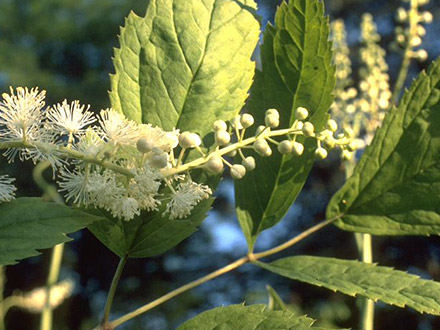Botanical name
Actaea racemosa L., Syn. Cimicifuga racemosa (L.) Nutt.
Family
Ranunculaceae
Common name
Black bugbane, Black snakeroot, Fairy candle, Rattle-top
Information about the plant
Black cohosh is native to eastern North America and Canada, where it grows in shady forests. It is also now found in Europe. Native American use the sliced rhizome for a wide variety of ailments. Due to its growing medicinal importance and the resulting increase in demand, it is now an endangered species and should be cultivated for this purpose. It can also be found as an ornamental plant in gardens and parks.
The genus name Actaea is derived from the Greek word for elderberry (= 'aktaia'). The genus name Cimicifuga is much more meaningful, and it is derived from Latin “cimex” (Gen. cimicis) (= bug), in combination with -fuga (Latin, fugare = to rout out), meaning that it can repel bugs. The intense smell of the plant is responsible for this characteristic, and the name black bugbane clearly reflects it further. The epithet racemosa refers to the large racemose inflorescences of rich white, almost silvery flowering plant.
The numerous small white flowers with prominent stamens sit in large clusters on the end of stalks up to 2m high, which protrude from the foliage of leaves. The leaves are two to three times pinnate; the individual leaflets are oblong and sharply serrated. The flowering time is from June to July.
Medicinally used parts of plants (herbal drug)
The underground parts of the plant are used, consisting of the rootstock (rhizome) and root (Cimicifugae rhizoma). They are harvested, washed, and dried after the fruit has ripened.
The commercially available drug comes from wild collections in certain areas of the USA and Canada.
Constituents of the herbal drug
Black cohosh rhizome (Cimicifuga rhizome) contains triterpene glycosides and phenylpropane derivatives.
Quality of the drug
The quality of cimicifuga rhizome (Cimicifugae rhizoma) is specified in the European Pharmacopoeia (Ph. Eur.).
Medical applications
Recognised medical use
The HMPC has accepted the internal use of black cohosh rhizome for the treatment of menopausal symptoms such as hot flashes and excessive sweating as “well-established use”.
ESCOP: menopausal symptoms such as hot flashes, profuse sweating, sleep disorders, and nervous irritability.
Traditional use
Black cohosh rootstock has not been classified as a traditional medicinal product.
Herbal drug preparations in finished dosage forms
- Black cohosh dry extracts (Cimicifuga dry extracts) in tablets and capsules
- Tincture in drops
- Cimicifuga racemosa homeopathic mother tincture in drops
Dosage
To ensure effectiveness, black cohosh rhizome should only be used in the form of finished medicinal products; the dosage is specified in the patient information leaflet.
Preparation of a tea
Tea preparations are not recommended.
Notes
Patients with liver dysfunction should take black cohosh with caution and stop taking the tablets as soon as any symptoms of liver failure appear (fatigue, anorexia, yellowing of the skin/eyes, or severe abdominal pain with nausea and vomiting and dark-colored urine). Seek medical advice immediately if vaginal bleeding occurs. Black cohosh rhizome should not be taken with estrogen. Also, patients who are or were receiving treatment for estrogen-dependent tumors (e.g. breast cancer) should not take black cohosh rhizome without medical advice. Administration of the drug during pregnancy and lactation is not recommended due to a lack of safety studies.
Side effects
Hepatotoxic reactions (hepatitis, jaundice, impaired liver function tests) have been observed (frequency not known). There have also been isolated cases of skin reactions, facial swelling, and gastrointestinal symptoms such as dyspepsia and diarrhea.
Interactions
None known.
References
Herbal drug monographs
HMPC (2018), ESCOP (2011), WHO Vol. 2
Further literature
Commentary on the European Pharmacopoeia (Cimicifuga rhizome, No. 2069)


